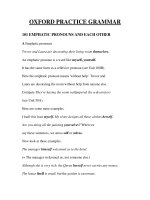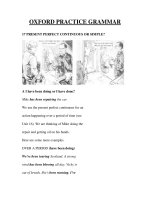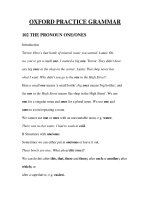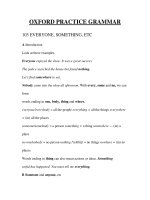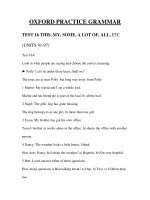Oxford Practice Grammar ppsx
Bạn đang xem bản rút gọn của tài liệu. Xem và tải ngay bản đầy đủ của tài liệu tại đây (5.98 MB, 823 trang )
Second edition(CONTENT ON PAGE 391)
Oxford
Practice
Grammar
with answers John Eastwood
Oxford University Press
Oxford University Press
Great Clarendon Street, Oxford
OX2 6DP
Oxford New York
Auckland Bangkok Buenos Aires
Cape Town Chennai Dar es
Salaam Delhi Hong Kong Istanbul
Karachi Kolkata Kuala Lumpur
Madrid Melbourne Mexico City
Mumbai Nairobi Sao Paulo
Shanghai Singapore Taipei Tokyo
Toronto
with an associated company in
Berlin
Oxford and Oxford English
are trade marks of Oxford
University Press.
ISBN 0 19 431369 7 (with answers)
ISBN 0 19 431427 8 (with answers
with CD-ROM)
ISBN 0 19 431370 0 (without
answers)
© Oxford University Press 1992,
1999
First published 1992 (reprinted nine
times)
Second edition 1999
Tenth impression 2002
Printing ref. (last digit): 6 5 4 3 2
1
No unauthorized photocopying
All rights reserved. No part of this
publication may be reproduced,
stored in a retrieval system, or
transmitted, in any form or by any
means, electronic, mechanical,
photocopying, recording or
otherwise, without the prior written
permission of Oxford University
Press.
This book is sold subject to the
condition that it shall not, by way of
trade or otherwise, be lent, resold,
hired out, or otherwise circulated
without the publisher's prior consent
in any form of binding or cover
other than that in which it is
published and without a similar
condition including this condition
being imposed on the subsequent
purchaser.
Illustrated by Richard Coggan
Designed by Richard Morris,
Stonesfield Design Typeset by
Tradespools Ltd., Frome,
Somerset Printed in China
Thanks
The author and publisher would like
to thank:
all the teachers in the United
Kingdom and Italy who discussed
this book in the early stages of its
development;
the teachers and students of the
following schools who used and
commented on the pilot units of
the first edition:
The Bell School of Languages,
Bowthorpe Hall,
Norwich
The Eckersley School of
English, Oxford
Eurocentre, Brighton
Eurocentre, London
Victoria King's School of
English, Bournemouth
Academia Lacunza -
International House, San
Sebastian, Spain
the teachers and students of the
following schools who used and
commented on the first edition of
this book:
Anglo World, Oxford
Central School of English,
London
Linguarama, Birmingham
Thomas Lavelle for his work on
the American English
appendix;
Rod Bolitho for his valuable
advice on what students need
from a grammar book.
The author would also like to thank:
Stewart Melluish, David Lott and
Helen Ward of Oxford University
Press for their expertise and their
commitment in guiding this
project from its earliest stages to
the production of this new
edition;
Sheila Eastwood for all her help
and encouragement.
Introduction
Who is this book for?
Oxford Practice Grammar is for
students of English at a middle or
'intermediate' level. This means
students who are no longer
beginners but who are not yet expert
in English. The book is suitable for
those studying for the Cambridge
First Certificate in English. It can be
used by students attending classes or
by someone working alone.
What does the book consist of?
The book consists of 153 units, each
on a grammatical topic. The units
cover the main areas of English
grammar. Special attention is given
to those points which are often a
problem for learners: the meaning of
the different verb forms, the use of
the passive, conditionals,
prepositions and so on.
Many units contrast two or more
different structures such as the
present perfect and past simple
(Units 14-15). There are also a
number of review units. The
emphasis through the whole book is
on the meaning and use of the forms
in situations. Most units start with a
dialogue, or sometimes a text, which
shows how the forms are used in a
realistic context.
There are also 25 tests. These
come after each group of units and
cover the area of grammar dealt with
in those units.
Each unit consists of an
explanation of the grammar point
followed by a number of exercises.
Almost all units cover two pages.
The explanations are on the left-hand
page, and the exercises are on the
right-hand page. There are a few
four-page units, with two pages of
explanation and two pages of
exercises.
The examples used to illustrate
the explanations are mostly in
everyday conversational English,
except when the structure is more
typical of a formal or written style
(e.g. Unit 75B).
There are also appendices on a
number of other topics, including
word formation, American English
and irregular verbs.
What's new about this edition?
There have been many changes in
both the content and design of the
book.
The number of units has been
increased from 120 to 153. There
are more two-page units and
fewer four-page units.
The 25 tests are a new feature.
There is also a Starting test to
help students find out what they
need to study.
There are many more dialogues
and illustrations on the
explanation pages. Many of the
examples and situations are new.
• There are many new
exercises and more different
types of exercise.
The number of appendices has
been increased from two to six.
This new edition features a group
of characters whose lives are the
basis for many of the situations in
both the explanations and the
exercises. (But you can still do
the units in any order.)
How should the book be used?
There are various ways of using the
book. If you know that you have
problems with particular points of
grammar, then you can start with the
relevant units. The contents list and
index will help you find what you
want. Or you can do the Starting test
(see page viii) and then use the
results to decide which parts of the
book to concentrate on. Or you can
start at the beginning of the book
and work through to the end,
although the grammar topics are not
ordered according to their level of
difficulty.
When you study a unit, start with
the explanation page and then go on
to the exercises. Often you can study
a part of the explanation and then do
one of the exercises. The letter after
each exercise title, e.g. (A), tells you
which part of the explanation the
exercise relates to. If you have made
mistakes in your answers to the
exercises, look back at the
explanation.
Key to symbols
What about the tests?
There are 25 tests at intervals through the book. You can do
a test after you have worked through a group of units. At the
beginning of each test you are told which units are being
tested.
The tests do two things. Firstly, they enable you to find
out how well you have mastered the grammar. (If you get
things wrong, you can go back to the relevant unit or part of
a unit.) Secondly, the tests give you practice in handling
exam-type questions. Many of the test questions are similar
to those used in the Cambridge First Certificate Use of
English Paper.
What's the best way to learn grammar?
It is usually more effective to look at examples of English
rather than to read statements about it. The explanations of
grammar in this book are descriptions of how English
works; they are a guide to help you understand, not 'rules' to
be memorized. The important thing is the language itself. If
you are learning about the present perfect continuous, for
example, it is helpful to memorize a sentence like We've
been waiting here for twenty minutes and to imagine a
situation at a bus stop like the one in Unit 16A. The
explanation - that the action happens over a period of time
lasting up to the present - is designed to help towards an
understanding of the grammar point. It is not intended that
you should write it down or memorize it.
Active learning will help you more than passive
reading, so it is important to do the exercises and to
check your answers.
Another way of actively learning grammar is to write
down sentences you see or hear which contain examples of
the grammar you are studying. You may come across such
sentences in English books or newspapers, on television or
on the Internet. You may meet English speakers. For
example, someone may ask you How long have you been
living here? Later you could note down this sentence as a
useful example of the present perfect continuous. It is also a
good idea to collect examples with a personal relevance like
I've been learning English for three years.
The symbol / (oblique stroke) between two words means
that either word is possible. I may/might go means that /
may go and I might go are both possible. In exercise
questions this symbol is also used to separate words or
phrases which need to be used in the answer.
Brackets ( ) around a word or phrase mean that it can be
left out. There's (some) milk in the fridge means that there
are two possible sentences: There's some milk in the fridge
and There's milk in the fridge.
The symbol ~ means that there is a change of speaker. In
the example How are you? ~ I'm fine, thanks, the two
sentences are spoken by different people.
The symbol > means that you can go to another place in
the book for more information. > 7 means that you can find
out more in Unit 7.
The symbol ► in an exercise means an example.
Starting test
This test will help you to find out which parts of the book
you need to spend most time on. You don't have to do the
whole test at once - you could do numbers 2 to 22 first to
test your knowledge of verbs. Choose the correct answer -
a), b), c) or d).
Some of the questions are quite difficult, so don't worry
if you get them wrong. This book was written to help
you get them right in future!
Words and sentences
1 We gave a meal.
a) at the visitors b) for the visitors c) the visitors d) to
the visitors
Verbs
2 I'm busy at the moment on the computer.
a) I work b) I'm work c) I'm working d) I working
3 My friend the answer to the question.
a) is know b) know c) knowing d) knows
4 I think I'll buy these shoes really well.
a) They fit b) They have fit c) They're fitting d) They
were fitting
5 Where the car?
a) did you park b) did you parked c) parked you d) you
parked
6 At nine o'clock yesterday morning we for the
bus.
a) wait b) waiting c) was waiting d) were waiting
7 When I looked round the door, the baby quietly.
a) is sleeping b) slept c) was sleeping d) were sleeping
8 Here's my report it at last.
a) I finish b) I finished c) I'm finished d) I've finished
9 I've made some coffee. It's in the
kitchen.
a) ever b) just c) never d) yet
10 We to Ireland for our holidays last year.
a) goes b) going c) have gone d) went
11 Robert ill for three weeks. He's still in
hospital.
a) had been b) has been c) is d) was
12 My arms are aching now because since two
o'clock.
a) I'm swimming b) I swam c) I swim d) I've been
swimming
13 I'm very tired. over four hundred
miles today.
a) I drive b) I'm driving c) I've been driving d)
I've driven
14 When Martin the car, he took it out for a
drive.
a) had repaired b) has repaired c) repaired d) was
repairing
15 Janet was out of breath because
a) she'd been running b) she did run c) she's been
running d) she's run
16 Don't worry. I be here to help
you.
a) not b) shall c) willn't d) won't
17Our friends meet us at the airport tonight.
a) are b) are going to c) go to d) will be to
18a party next Saturday. We've sent out the
invitations.
a) We had b) We have c) We'll have d) We're having
19I'll tell Anna all the news when her.
a) I'll see b) I'm going to see c) I see d) I shall see
20At this time tomorrow over the Atlantic.
a) we flying b) we'll be flying c) we'll fly d) we to fly
21Where's Robert? a shower?
a) Does he have b) Has he c) Has he got d) Is he having
22I like that coat. It's really nice.
a) am b) do c) very d) yes
Questions, negatives and answers
23What's the weather like in Canada? How often. there?
a) does it snow b) does it snows c) snow it d) snows it
24Which team the game?
a) did it win b) did they win c) won d) won it
25What did you leave the meeting early ? ~ I didn't feel
very well.
a) away b) because c) for d) like
26Unfortunately the driver the red light.
a) didn't saw b) didn't see c) no saw d) saw not
27You haven't eaten your pudding it?
a) Are you no want b) Do you no want c) Don't want you
d) Don't you want
28I really enjoyed the disco. It was great, ?
a) is it b) isn't it c) was it d) wasn't it
29Are we going the right way? ~ I think
a) indeed b) it c) so d) yes
Modal verbs
30 The chemist's was open, so luckily I
buy some aspirin.
a) can b) can't c) did can d) was able to
31 Susan has to work very hard. I
do her job, I'm sure.
a) can't b) couldn't c) don't d) shouldn't
32 We had a party last night
spend all morning clearing up
the mess.
a) I must have b) I've been to c) I've had to d) I've must
33 There was no one else at the box office. I
in a queue.
a) didn't need to wait b) mustn't wait c) needn't have waited d)
needn't wait
34
I carry that bag for you? ~ Oh, thank you.
a) Do b) Shall c) Will d) Would
Adjectives and adverbs
68 The house was building.
a) a nice old stone b) a nice stone old c) a stone old nice d)
an old nice stone
69 The government is doing nothing to help
a) poor b) the poor c) the poors d) the poor ones
70 The young man seems very
a) sensible b) sensiblely c) sensibley d) sensibly
71 I missed the bus. I was only just in time to
catch it.
a) mostly b) near c) nearest d) nearly
72 This detailed map is the atlas.
a) more useful as b) more useful than c) usefuller as d)
usefuller than
73 This place gets crowded with tourists every
summer.
a) always more b) crowded and more c) from more to more
d) more and more
74 Yes, I have got the report it.
a) I just am reading b) I'm just reading c) I'm reading just d)
Just I'm reading
75 I've read this paragraph three times, and I understand it.
a) can't still b) can't yet c) still can't d) yet can't
76 We're really sorry. We regret what happened
a) a bit b) much c) very d) very much
Prepositions
77 The village is Sheffield. It's only six miles away.
a) along b) by c) near d) next
78 You can see the details the computer screen.
a) at b) by c) in d) on
79 I've got a meeting Thursday afternoon.
a) at b) in c) on d) to
80 We've lived in this flat five years.
a) ago b) already c) for d) since
81 This car is , if you're interested in buying it.
a) for sale b) in sale c) at sale d) to sell
82 Polly wants to cycle round the world. She's really keen. . the
idea.
a) about b) for c) on d) with
Verbs with prepositions and adverbs
83 I prefer dogs cats. I hate cats.
a) from b) over c) than d) to
84 My father used the money he won to set his own
company.
a) forward b) on c) out d) up
85 Don't go too fast. I can't keep you.
a) on to b) on with c) up to d) up with
Reported speech
86Someone the tickets are free.
a) said me b) said me that c) told me d) told to me
87Last week Justin said 'I'll do it tomorrow.' He said he would do it
a) the following day b) the previous day c) tomorrow d) yesterday
88I don't know why Nancy didn't go to the meeting. She said she
definitely going.
a) be b) is c) was d) would
89The librarian asked us so much noise.
a) don't make b) not make c) not making d) not to make
Relative clauses
90What's the name of the man gave us a lift?
a) he b) what c) which d) who
91What was that notice ?
a) at that you were looking b) you were looking at c) you were
looking at it d) which you were looking
92Susan is the woman husband is in hospital.
a) her b) hers the c) whose d) whose the
93York, last year, is a nice old city.
a) I visited b) that I visited c) which I visited d) whom I visited
94The accident was seen by some people at a bus stop
a) waited b) waiting c) were waiting d) who waiting
Conditionals and wish
95If my passport, I'll be in trouble.
a) I lose b) I'll lose c) I lost d) I would lose
96I haven't got a ticket. If one, I could get in.
a) I'd have b) I had c) I have d) I've got
97If the bus to the airport hadn't been so late, we the plane.
a) caught b) had caught c) would catch d) would have caught
98If only people keep sending me bills!
a) don't b) shouldn't c) weren't d) wouldn't
Linking words
99I just had to take the dog out of the awful weather.
a) although b) despite c) even though d) in spite
100 Anna put the electric fire on
warm.
a) for getting b) in order get c) so she gets d) to get
1. Word classes: nouns, verbs, adjectives, etc
A Introduction
Look at the different kinds of word in this sentence.
Pronoun Verb Determiner Adjective Noun Preposition Noun
Adverb
I
have an important conference at work tomorrow,
Linking word Pronoun Verb Adverb
Adjective
So
I
am rather
busy.
B What kind of word?
There are eight different kinds of word in English. They are called 'word
classes' or 'parts of speech'. Here are some examples from the conversations
in the cafe. The numbers after the examples tell you which units in the book
give you more information. 1 Verb: have, am, is, would, like, come, are,
sitting, look 4-75
Noun: conference, work, coffee, party, Saturday, Jessica, friends,
corner 76-82
Adjective: important, busy, good, cheap 104-109
Adverb: tomorrow, rather, really, here 113-117
Preposition: at, to, on, in 118-125
Determiner: an, this, our, the 83-97
Pronoun: I, it, you 98-103
Linking word: so, and 150-153
C Words in sentences
Some words can belong to different classes depending on how they are used
in a sentence.
VERBS
Can I look at your
photos? We work on
Saturday morning.
NOUNS
I like the look of
that coat. I'll be at
work tomorrow.
1 Exercises
1 What kind of word? (B)
Read this paragraph and then say which word class each underlined
word
belongs to. To help you decide, you can look back at the examples in B.
Andrew didn't go to the cafe
with the other students. Rachel told him they
were going there
, but he wanted to finish
his work. Andrew isn't very sociable
.
He stays in his room and concentrates totally
on his studies. He's an excellent
student, but he doesn't have much fun
.
?
to preposition
7 sociable
?
cafe noun 8 in ………………………
1
the…………………………. 9 and …………………….
2
told………………………… 10 totally …………………….
3
they……………………….
11 an
………………………
4
there …………………….
12excellent …………………….
5
he ………………………… 13 but ……………………
6
finish ……………………
14 fun
…………………
2 What kind of word? (B)
Read this paragraph and then write the words in the spaces below. Write the first
three verbs under 'Verb', and so on. Do not write the same word more than once.
Henry thinks Claire is wonderful. He loves her madly, and he dreams of
marrying her, but unfortunately he is rather old for her. Today they are at a cafe
with their friends Sarah and Mark, so Henry can't get romantic with Claire. But
he might buy her some flowers later.
Verb Noun Adjective Adverb
think
Henry .
Preposition Determiner Pronoun Linking word
3 Words in sentences (C)
Is the underlined
word a verb, a noun or an adjective?
?
Shall we go for a walk? noun
?
Shall we walk into town? verb
1
Laura wanted to talk
to Rita.
2
Laura wanted a talk
with Rita.
3
The windows aren't very clean
.
4
Doesn't anyone clean
the windows?
5
We went to a fabulous show
in New York.
6
Laura wanted to show
Rita her photos.
7
Henry thought
Claire looked beautiful.
8
A strange thought
came into Emma's head.
9
Sarah is feeling quite tired
now.
10
Studying all night had tired
Andrew out.
2. Sentence structure: subject, verb, object, etc
Sentence structure
The parts of a sentence are the
subject, verb, object,
complement and adverbial. A
statement begins with the subject
and the verb. There are five main
structures which we can use to
make a simple statement.
1 SUBJECT VERB
My arms are
aching.
Something
happened.
2 SUBJECT VERB
OBJECT
/ need a rest.
Five people are moving
the piano.
The subject and object can be
a pronoun (e.g. I) or a noun
phrase (e.g. the piano).
3 SUBJECT VERB
COMPLEMENT
This piano is
heavy.
It was a big problem.
The complement can be an
adjective (e.g. heavy) or a noun
phrase (e.g. a big problem). The
complement often comes after
be. It can also come after appear,
become, get, feel, look, seem,
stay or sound. For adjectives and
word order see Unit 104B.
4 SUBJECT VERB
ADVERBIAL
It is on my
foot.
Their house is
nearby.
An adverbial can be a
prepositional phrase (e.g. on my
foot) or an adverb (e.g. nearby).
5 SUBJECT VERB OBJECT
OBJECT
It s giving me
backache.
David bought Melanie
a present.
We use two objects after verbs
like give and send (see Unit 3).
B Adverbials
We can add adverbials to all the five main structures.
My arms are aching terribly. I really need a rest.
Of course this piano is heavy. Fortunately their
house is nearby. To everyone's surprise, David
actually bought Melanie a present yesterday.
34, 36 Word order in questions 113 Adverbs and word order page
377 Seem, look etc in American English
2 Exercises
1 Parts of the sentence (A)
Mike and Harriet are on holiday. They have written a postcard to
David and Melanie. Look at each underlined
phrase and say what
part of the sentence it is: subject, verb, object, complement or
adverbial. ► We're having a great time. object
1 The weather is marvellous. 4 We're on a farm
.
2 We really enjoy camping. 5 We like this place
.
3 It's great fun. 6 The scenery is beautiful
.
2 Sentence structure (A)
After moving the piano, the five friends had a rest and a cup of tea.
Look at this part of their conversation and then write the letters a)-
e) in the correct place.
a
Davi
That was a difficult
b
Tom:
I agree.
c
Mike
I'm on my deathbed.
d
Davi
Someone should give
e
Harri
I've made some more
► Subject + verb b
1 Subject + verb + object
2 Subject + verb + complement
3 Subject + verb + adverbial
4 Subject + verb + object + object
3 Word order (A)
Put the words in the correct order and write the statements.
► is / Melanie / very nice Melanie is
very nice.
1 football / likes / Tom
………………………………………………
2 an accident / David / had
………………………………………………
3 moved / the piano / we
………………………………………………
4 a tall woman / Harriet / is
………………………………………………
5 sat / on the floor / everyone
………………………………………………
6 gave / some help / Mike's friends / him
4 Adverbials (B)
These sentences are from a news report. Write down the two
adverbials in each sentence. Each adverbial is a
prepositional phrase or an adverb.
► Prince
Charles opened a new sports
in Stoke
centre in Stoke yesterday.
yesterday
1 He also spoke with
several young
people.
2 The sports centre
was first
planned in 1994.
3 Naturally, the local council
could not
finance the project without
help.
4 Fortunately, they
managed to obtain
money from the
National Lottery.
3 Direct and indirect objects
A Introduction
Henry gave Claire some flowers.
Here the verb give has two objects.
Claire is the indirect object, the
person receiving something. Some
flowers is the direct object, the
thing that someone gives.
Here are some more examples of the
two structures.
INDIRECT OBJECT
DIRECT OBJECT
Emma gave Rachel a CD.
I'll send my cousin a
postcard.
We bought all the children an
ice-cream.
DIRECT
OBJECT
Emma gave the
CD I'll send a
postcard We
bought ice-
creams
PHRASE
WITH
TO/FOR
to Rachel.
to my cousin.
for all the
children.
B To or for?
We give something to someone, and we buy something for
someone.
We can use to with these verbs: bring, feed, give, hand,
lend, offer, owe, pass, pay, post, promise, read, sell, send,
show, take, teach, tell, throw, write
Vicky paid the money to the cashier, OR Vicky paid the
cashier the money. Let me read this news item to you.
OR Let me read you this news item. We showed the
photos to David, OR We showed David the photos.
We can use for with these verbs: book, bring, build,
buy, choose, cook, fetch, find, get, leave, make,
order, pick, reserve, save
They found a spare ticket for me. OR They found me a
spare ticket.
I've saved a seat for you. OR I've saved you a seat.
Melanie is making a cake for David, OR Melanie is
making David a cake.
Henry gave some flowers to
Claire. Here give has a direct object
(some flowers) and a phrase with
to. To comes before Claire, the
C Give + pronoun
Sometimes there is a pronoun and a noun after a verb such
as give.
The pronoun usually comes before the noun.
Henry is very fond of Claire. He gave
her some flowers.
We use her because Claire is
mentioned earlier. Her comes
before some flowers.
Henry bought some flowers. He
gave
them to Claire.
We use them because the flowers

